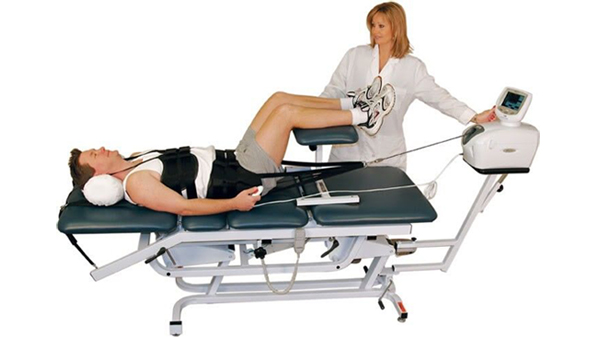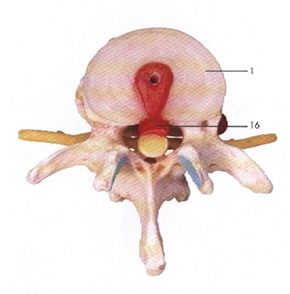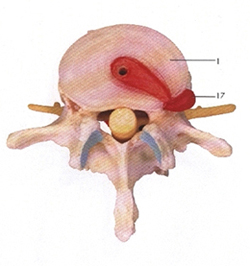
Spinal Decompression Therapy (SDT) is a non-surgical form of treatment for back and neck pain pain caused by herniated discs, disc bulges and/or degenerative disc disease. To fully understand and appreciate what spinal decompression is how it can help a herniated disc, let’s first talk about what a normal, healthy (intervertebral) disc is.
What is an intervertebral disc?
The intervertebral disc, or simply “disc”, is the material that exists between any two vertebrae in the spine, with the only exception being between the first two bones in your neck in which there is no disc. The disc material is made up of fibro-cartilage and fibrous tissue at it’s circumference which are formed in to concentric bands much like the bands, or, rings seen in a tree trunk. The center of the disc consists of a soft, yellowish colored, elastic pulpy matter known as the nucleus pulposus. The disc is shown in the figure below and is labeled #1.

Figure 1.
The purpose of the disc is to separate the vertebrae far enough away from each other and provide space for the exiting spinal nerves from the spinal cord. The discs also help shape the curves in your spine and they act like shock absorbers throughout your whole back when you are involved in physical activity, such as walking and running. In a healthy disc, the rings that form the circumference keep the contents of the nucleus pulposus directly in the center.
What is a herniated disc?
Sometimes however, the rings that contain the nucleus pulposus can be broken down one by one over time, or, all at once as in a sudden traumatic accident When this happens the soft, yellow, pulpy matter in the middle can no longer be contained there and begins to migrate through the broken rings as shown in Figure 2 below (item #17) and put pressure either on your spinal nerves, or, towards the back and put pressure on your spinal cord as in Figure 1 (item 16) above. The resultant migration of the nucleus pulposus and its exit outside the disc is the basis of the condition known as a herniated disc.

A herniated disc is considered a space occupying lesion. It is given this name because where there once was space, as in next to the spinal nerves or spinal cord, there is now very little since the herniation (nucleus pulposus) is now taking up space where it doesn’t belong, crowding the spinal nerves or cord.
Disc Protrusions and Extrusions
Disc protrusions and extrusions are also herniations and are defined based on how much of an opening is formed on the outside of the disc as well as how much of the nucleus pulposus has leaked out.
If the width of the opening on the outside of the disc is larger than the length of the material sticking out, it is considered a disc protrusion. If the length of the disc material sticking out is greater than the length or size of its opening, then it is considered an extrusions.
Symptoms of a Herniated Disc
Symptoms of a herniated disc in the lower back, or, lumbar spine include the following:
- Lower back pain near the site of herniation.
- Pain down into the thigh, lower leg, feet and toes.
- Numbness and Tingling down in the legs and feet.
- Loss of strength in the calves and big toes.
- Loss of bowel and/or bladder control.
- Cold feet.
Symptoms of a herniated disc in the neck, or, cervical spine include the following:
- Neck pain near the site of herniation.
- Magnifying pain at the base of the skull.
- Pain radiating into the shoulders arms, hands and fingers.
- Sharp, electrical pain into the arms and hands.
- Numbness and tingling down in the arms and hands.
- Cold hands.
- Loss of grip strength.
- Loss of pinch strength.
Prior treatment and affects of herniated discs.
Herniated discs symptoms have traditionally been treated with steroid injections and/or surgery however neither provided the solution many patients were looking for.
How Spinal Decompression Therapy For Herniated Discs Works.
Now that you have a good ideas of what a herniated disc is, let’s talk about how spinal decompression therapy helps to fix them. Spinal decompression therapy for herniated discs starts off by placing you on a comfortable table laying down on your back side. Your upper body and rib cage area is secured to the upper part of the table using a velcro support brace. A second support brace is wrapped around your abdomen just above your pelvis. A small cable is attached to the backside of this second support brace. This will serve as the decompression device. The table is then either raised or lowered. This alters the angle of pull form the computerized motor where the cable originates from which is situated at the foot of the table. The angle of pull determines the specific level where decompression takes place.
Why are herniated discs painful?
Now what makes a herniated disc so painful is two things: 1) the nucleus pulposus has migrated either off to the side or back putting pressure on the spinal nerve or spinal cord and 2) since the nucleus pulposus has been displaced, the overall height of the disc has decreased. This decrease in disc height will limit the amount of space between two adjacent vertebrae causing even more pressure to be exerted on the spinal cord and spinal nerves.
Therefore, the overall goal of spinal decompression therapy for herniated discs is to restore the proper spacing between two adjacent vertebrae and also to pull or suck the contents of the damaged nucleus pulposus back towards their normal middle position.
A Feeling of Weightlessness
The way this is accomplished lies in the engineering of the table and the positioning of the patient. Since the patient is laying down on their back, with their upper body and rib cage fixed to the table, there is very little muscle guarding around the injured part of the spine. A feeling of weightlessness, with respect to the spine, is present. This is important because any type of muscle guarding will prevent the spine form separating back to its normal position and prevent true decompression from taking place. As the computer begins to draw the cable towards itself, a mild separation between two vertebrae begins to take place. Again, the exact level of separation, for example L4/L5, depends upon the height of the table, position of the patient and angle of pull from the computer.
Creating Negative Pressure is a Good Thing
Since the disc material is made up mostly of water, when two adjacent vertebrae begin to separate, a negative hydrostatic pressure inside the injured disc begins to take place. This negative pressure in turn draws anything immediately surrounding it back towards the middle, in this case, the contents of the nucleus pulposus gets drawn back into the middle of the disc where it belongs. This in turn removes the pressure off of the spinal nerve and spinal cord and an immediate sense of relief is felt.
It is important to note here that your normal everyday traction that you might receive at a hospital or physical therapy office using weights and pulleys can never create true decompression. There is no way possible for this type of system to create a negative pressure inside the disc to suck the contents of the nucleus pulposus back towards the middle.
This is due to the muscle guarding reflex that still remains around the spine. What you get in effect is a basic tug-of-war between the entire upper body and entire lower body. Muscle strains are common with this antiquated type of traction.
Schedule Your Appointment, Today!
Call our office in Columbus, Ohio today to see if you are a candidate for spinal decompression therapy.
………………………………………………
How many spinal decompression treatments will it take to correct a herniated disc?
How long before I notice a difference in my symptoms?